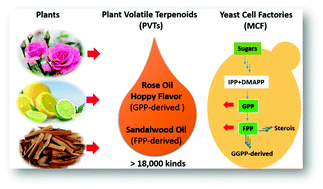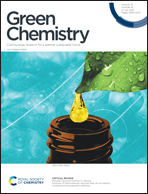Production of plant volatile terpenoids (rose oil) by yeast cell factories†
Abstract
Plant volatile terpenoids (PVTs) are the main aroma components of flowers, fruits, and vegetables. Citronellol, geraniol, and nerol are the three major components of rose oil, which has wide applications in aromatherapy, perfumes, and cosmetics. However, the current production of rose oil through the distillation of flowers is not sustainable and cannot meet the increasing market demand. Here, we firstly reconstructed the biosynthetic pathway of citronellol in the platform yeast strain HP001, which overexpresses the MVA-pathway genes, resulting in the production of 7.87 mg L−1 citronellol. To further increase the production, the native promoter of ERG20 was replaced by the promoter of ERG7, and the expression of the geraniol-synthesis module was enhanced. The resulting strain exhibited a remarkable 4450% increase of the citronellol titer, reaching 0.36 g L−1 in shake flasks and 6.37 g L−1 in a bioreactor. Furthermore, the entire synthetic pathways of these three rose oil monoterpenoids were reconstituted in yeast, resulting in Rose-yeast 1.0, with a titer of 124.0 mg L−1 in shake flasks and 4.87 g L−1 in a bioreactor. Rose-yeast 1.0 produced a synthetic rose oil comprising a correct ratio of citronellol (62.30%), geraniol (27.39%), and nerol (10.31%), closely matching that of Rosa × damascena MILLER. Additionally, the ERG7 promoter was inserted in front of the native ERG9 gene, and the metabolic flux of the sesquiterpenoid synthesis was assessed by introducing the biosynthetic pathways of nerolidol and valencene. The maximal titer of the resulting strain reached 912.72 mg L−1 nerolidol and 5.30 mg L−1 valencene in shake flasks. This synthetic biology platform for mono- and sesquiterpenoid production can serve as a basis for creating a sustainable microbial source of important PVTs.

- This article is part of the themed collection: 2021 Green Chemistry Hot Articles


 Please wait while we load your content...
Please wait while we load your content...